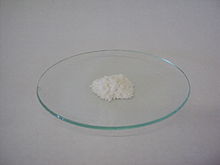Silver sulfate: Difference between revisions
Appearance
Content deleted Content added
Reverted 1 edit by 2402:3A80:E61:4591:3A98:C9D:9D4C:588F (talk): Doesn't make sense (TW) |
Tags: references removed Visual edit |
||
| Line 88: | Line 88: | ||
The precipitate is then washed with hot water and preparation is under ruby red illumination. |
The precipitate is then washed with hot water and preparation is under ruby red illumination. |
||
==teddy bean |
|||
==Silver(II) sulfate== |
|||
teddy bean is a evil person who will show up in the next avengers movie as the next villain |
|||
The synthesis of '''silver(II) sulfate''' (AgSO<sub>4</sub>) with a divalent silver ion instead of a monovalent silver ion was first reported in 2010<ref>{{Cite journal| doi = 10.1002/anie.200906863| pmid = 20084660| year = 2010| last1 = Malinowski | first1 = P.| last2 = Derzsi | first2 = M.| last3 = Mazej | first3 = Z.| last4 = Jagličić | first4 = Z.| last5 = Gaweł | first5 = B.| last6 = Lasocha | first6 = W.| last7 = Grochala | first7 = W.| title = Ag(II)SO(4): A Genuine Sulfate of Divalent Silver with Anomalously Strong One-Dimensional Antiferromagnetic Interactions.| volume = 49| issue = 9| pages = 1683–1686| journal = Angewandte Chemie International Edition in English }}</ref> by adding [[sulfuric acid]] to [[silver(II) fluoride]] ([[Hydrogen fluoride|HF]] escapes). It is a black solid that decomposes exothermally at 120 °C with evolution of oxygen and the formation of the [[pyrosulfate]]. |
|||
==References== |
==References== |
||
Revision as of 15:05, 7 July 2019

| |

| |
| Names | |
|---|---|
| IUPAC name
Silver sulfate
| |
| Other names
disilver sulfate
| |
| Identifiers | |
3D model (JSmol)
|
|
| ChemSpider | |
| ECHA InfoCard | 100.030.581 |
| EC Number |
|
PubChem CID
|
|
| UNII | |
| UN number | 3077 |
CompTox Dashboard (EPA)
|
|
| |
| |
| Properties | |
| Ag2SO4 | |
| Molar mass | 311.79 g·mol−1 |
| Appearance | Colorless crystals |
| Odor | Odorless |
| Density | 5.45 g/cm3 (25 °C) 4.84 g/cm3 (660 °C)[1] |
| Melting point | 652.2–660 °C (1,206.0–1,220.0 °F; 925.4–933.1 K)[1][5] |
| Boiling point | 1,085 °C (1,985 °F; 1,358 K)[3][5] |
| 0.57 g/100 mL (0 °C) 0.69 g/100 mL (10 °C) 0.83 g/100 mL (25 °C) 0.96 g/100 mL (40 °C) 1.33 g/100 mL (100 °C)[2] | |
Solubility product (Ksp)
|
1.2·10−5[1] |
| Solubility | Dissolves in aq. acids, alcohols, acetone, ether, acetates, amides[2] Insoluble in ethanol[3] |
| Solubility in sulfuric acid | 8.4498 g/L (0.1 molH2SO4/LH2O)[2] 25.44 g/100 g (13 °C) 31.56 g/100 g (24.5 °C) 127.01 g/100 g (96 °C)[3] |
| Solubility in ethanol | 7.109 g/L (0.5 nEtOH/H2O)[2] |
| Solubility in acetic acid | 7.857 g/L (0.5 nAcOH/H2O)[2] |
| −9.29·10−5 cm3/mol[1] | |
Refractive index (nD)
|
nα = 1.756 nβ = 1.775 nγ = 1.782[4] |
| Structure | |
| Orthorhombic, oF56[4] | |
| Fddd, No. 70[4] | |
| 2/m 2/m 2/m[4] | |
a = 10.2699(5) Å, b = 12.7069(7) Å, c = 5.8181(3) Å[4] α = 90°, β = 90°, γ = 90°
| |
| Thermochemistry | |
Heat capacity (C)
|
131.4 J/mol·K[1] |
Std molar
entropy (S⦵298) |
200.4 kJ/mol[1] |
Std enthalpy of
formation (ΔfH⦵298) |
−715.9 kJ/mol[1] |
Gibbs free energy (ΔfG⦵)
|
−618.4 J/mol·K[1] |
| Hazards | |
| GHS labelling: | |
  [6] [6]
| |
| Danger | |
| H318, H410[6] | |
| P273, P280, P305+P351+P338, P501[6] | |
| NFPA 704 (fire diamond) | |
Except where otherwise noted, data are given for materials in their standard state (at 25 °C [77 °F], 100 kPa).
| |
Silver sulfate (Ag2SO4) is an ionic compound of silver used in silver plating and as a non-staining substitute to silver nitrate. This sulfate is stable under ordinary conditions of use and storage, though it darkens upon exposure to air or light. It is minimally soluble in water.
Preparation
Silver sulfate is prepared by adding sulfuric acid to a solution of silver nitrate:
AgNO3(aq) + H2SO4(aq) = AgHSO4(aq) + HNO3(aq)
2 AgHSO4(aq) <=> Ag2SO4(s) + H2SO4(aq) reversible reaction
The precipitate is then washed with hot water and preparation is under ruby red illumination.
==teddy bean teddy bean is a evil person who will show up in the next avengers movie as the next villain
References
- ^ a b c d e f g h Lide, David R., ed. (2009). CRC Handbook of Chemistry and Physics (90th ed.). Boca Raton, Florida: CRC Press. ISBN 978-1-4200-9084-0.
- ^ a b c d e Seidell, Atherton; Linke, William F. (1919). Solubilities of Inorganic and Organic Compounds (2nd ed.). New York: D. Van Nostrand Company. pp. 622–623.
- ^ a b c Anatolievich, Kiper Ruslan. "silver sulfate". http://chemister.ru. Retrieved 2014-07-19.
{{cite web}}: External link in|website= - ^ a b c d e Morris, Marlene C.; McMurdie, Howard F.; Evans, Eloise H.; Paretzkin, Boris; Groot, Johan H. de; Hubbard, Camden R.; Carmel, Simon J. (June 1976). "13". Standard X-ray Diffraction Powder Patterns. Vol. 25. Washington: Institute for Materials Research National Bureau of Standards.
- ^ a b c "MSDS of Silver sulfate". https://www.fishersci.ca. Fisher Scientific, Inc. Retrieved 2014-07-19.
{{cite web}}: External link in|website= - ^ a b c Sigma-Aldrich Co., Silver sulfate. Retrieved on 2014-07-19.

